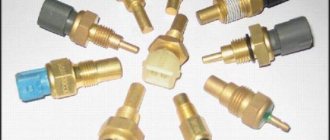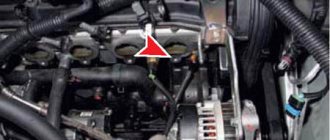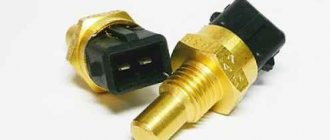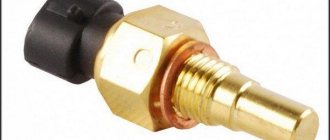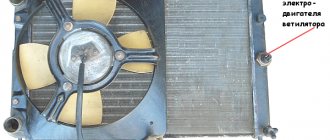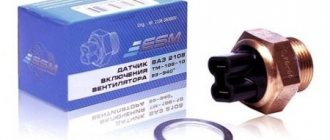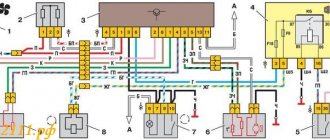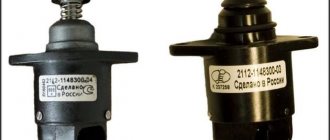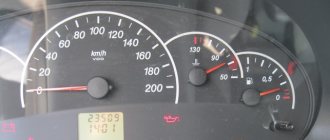The tenth family of the Tolyatti auto giant was equipped with injection engines. The first releases of cars were with 8-valve heads, and subsequent ones with 16-valve heads. Both engines were equipped with electronic control units (hereinafter referred to as ECU). The main controller collects readings from several sensors and adjusts the balanced operation of the engine (hereinafter referred to as the internal combustion engine). The temperature sensor on the VAZ 2110 is also responsible for interacting with the computer, and if it malfunctions, the “Check Engine” signal lights up, which in English means “Check the engine.” Next, we will tell you where the temperature sensor is located on the VAZ 2110, how to check and change it.
Attention! The injection "tens" have 2 coolant sensors. One for the arrow on the dashboard, and the second for exchanging data with the ECU and turning on the radiator fan. It's called DTOZH. The article is dedicated to him.
PURPOSE OF TEMPERATURE SENSOR VAZ 2107
The sensor monitors the temperature of antifreeze in the main cooling radiator of the VAZ 2107 and transmits the signal to the dashboard. In its lower left corner there is a dial indicator for the antifreeze temperature.
Sensor showing coolant temperature VAZ 2107
If the temperature rises above 95 degrees, this means only one thing: the cooling system is not doing its job and the engine is close to overheating.
The temperature sensor of the VAZ 2107 transmits a signal to the dashboard
Examination
Today, VAZ 2109 car owners use two methods to check the condition of the coolant temperature sensor. Let's say right away that the second one is more reliable, but the first one is easier. Decide for yourself which of the methods presented below to use.
| Verification method | Your actions |
| First way |
|
| Second way |
|
According to the table, check whether the resistance corresponds to that required at a particular temperature of coolant or boiling water.
| Temperature (in degrees Celsius) | Resistance (Ohm) |
| 100 degrees | 177 |
| 80 degrees | 332 |
| 60 degrees | 667 |
| 40 degrees | 1459 |
| 20 degrees | 3520 |
| 0 degrees | 9420 |
| -20 degrees | 28680 |
| -40 degrees | 100700 |
If there are deviations from the norm, we conclude that the sensor no longer performs its functions properly and therefore requires mandatory replacement.
Replacement
ANTIFREEZE TEMPERATURE SENSOR DEVICE
Over the years, different types of temperature sensors were installed on VAZ 2107 cars. The earliest VAZ 2107 models had electromechanical sensors. Later they were replaced by electronic sensors. Let's take a closer look at the design of these devices.
ELECTROMECHANICAL TEMPERATURE SENSOR
Electromechanical sensors have a massive steel body with thick walls, ensuring more uniform heating of the device. The body contains a chamber with ceresite. This substance is mixed with copper powder, and it reacts well to changes in temperature. The ceresite chamber of the sensor is closed by a very sensitive membrane connected to the pusher. When hot antifreeze heats the sensor body, the ceresite in the chamber expands and begins to put pressure on the membrane. The membrane moves up a pusher, which closes the system of moving contacts. The signal thus obtained is transmitted to the dashboard, informing the driver that the engine is overheating.
The device of the electromechanical temperature sensor VAZ 2107
ELECTRONIC TEMPERATURE SENSOR
Electronic temperature sensors are installed only on new VAZ 2107. Instead of a membrane and a chamber with ceresite, the electronic sensor has a sensitive thermistor. As the temperature increases, the resistance of this device changes. These changes are recorded by a special circuit, which transmits a signal to the dashboard.
Electronic sensor device VAZ 2107
LOCATION OF ANTIFREEZE TEMPERATURE SENSOR ON VAZ 2107
The temperature sensor is screwed into the main cooling radiator of the VAZ 2107. This arrangement is quite natural: this is the only way the sensor can come into direct contact with boiling antifreeze. One nuance should be noted here: on early VAZ 2107 models, the temperature sensor also served as a plug closing the hole for draining antifreeze. In new VAZ 2107 cars, the drain hole is closed with a special plug, and the temperature sensor is screwed into its own, separate socket.
In old VAZ 2107 models, the temperature sensor also served as a plug
Sensor design
The sensor is a thermoelement placed in a bronze shell. It has direct contact with antifreeze, and the thermoelement, which is enclosed in the sensor, changes its resistance as the temperature rises or falls and transmits the received readings to the computer.
The sensor has a threaded connection sealed with a special copper ring; on the top of the sensor there is a connector for connecting a plug.
TEMPERATURE SENSOR FAULTS
There are two reasons why the sensor may not transmit a signal to the dashboard. Here they are:
- The fuse responsible for the temperature sensor has blown (the sensor itself may be working properly). To understand that the problem is in the fuse, the driver will have to look under the steering column, into the fuse block of the car. A burnt fuse will be immediately visible: it usually melts slightly and turns black;
Sometimes the sensor does not work due to a blown VAZ 2107 fuse - The temperature sensor itself has burned out. As a rule, this occurs due to a sharp voltage drop in the vehicle's on-board electrical network. The cause of such a jump may be a short circuit in the electrical wiring. The fact is that the insulation of wires on the VAZ 2107 has never been of high quality. Over time, it becomes unusable and begins to crack, which ultimately leads to a short circuit.
CHECKING THE TEMPERATURE SENSOR VAZ 2107
To carry out the test we will need the following tools:
- household multimeter;
- container with water;
- household boiler;
- thermometer;
- temperature sensor removed from the car.
TEST SEQUENCE
- The sensor is lowered into the prepared container so that its threaded part is completely under water.
- A thermometer and a boiler are lowered into the same container (you need to make sure that these tools do not come into contact with each other).
- The multimeter contacts are connected to the sensor contacts, and the multimeter itself is configured to measure resistance.
- The boiler is plugged in and the water starts heating.
- When the water reaches a temperature of 95 degrees, the sensor resistance shown by the multimeter should disappear. If this happens, the sensor is working. If at the above temperature the resistance on the multimeter does not disappear, the sensor is faulty and needs to be replaced.
VIDEO: CHECKING THE ANTIFREEZE SENSOR
Replacement
It is not difficult to replace the DTOZH with your own hands on an injection VAZ 2109. Follow the step-by-step instructions to resolve any issues that may arise.
Removing the device
- First of all, check the condition of the fuses. It is not uncommon for them to burn out, which causes a failure of the coolant temperature sensor.
- Wait until the car has cooled down completely. Under no circumstances should you replace the DTOZH on a hot engine.
- Disconnect the wires going to your DTOZH. You just need to do this in a situation where, when you turn on the ignition, the temperature indicator needle begins to rise sharply and sometimes reaches the maximum level.
- If no changes occur with the arrow, the fault is not with the sensor itself, but with the wire going to it.
- If the needle starts to drop when you turn on the ignition, the coolant temperature sensor has failed and needs to be replaced.
- There is no need to remove half of the units to get to the DTOZH. Access to the device is free, there should be no problems.
- Drain the coolant from the system. This is an excellent reason to at the same time change the antifreeze for a new one, if necessary. If the coolant is fresh, use a clean container to drain it.
- Disconnect the wiring from the sensor.
- Using a socket, unscrew the regulator so that it can be easily removed by hand.
- Clean the device landing area. This usually accumulates a decent amount of dirt and dust, which can cause the new antifreeze temperature sensor to not work correctly.
- To clean, use any rag that does not leave behind lint or threads.
- Treat the nest with a degreaser.
- Insert the new regulator. The mistake of many is that, supposedly to increase the reliability of the installation, they seal the sensor with sealant. You shouldn’t do this, because this way the DTOZH can only work worse.
- Replace the power cord. Only if the check shows that it has a break or is damaged, it is better to replace the wire immediately. We do not recommend repairing it with electrical tape.
- Pour coolant back into the system. Even if you changed the coolant a couple of months ago, it is better to replace it with a fresh one at the same time. It definitely won't get any worse.
- Start the engine and check the operation of the new TOZ sensor.
Replacing the DTOZ yourself is a fairly simple process. You don’t have to spend money on car service services, plus you’ll get the necessary experience in car repairs yourself.
REPLACING ANTI-FREEZE SENSOR ON A VAZ 2107
First of all, it should be said that the temperature sensors on the VAZ 2107 cannot be repaired. The reason is simple: this device does not contain parts and materials that the driver could purchase and replace himself. In addition, the body of the temperature sensor is not dismountable, so it is simply impossible to get to the insides of this device without breaking it. Here's what you need to replace it:
- new temperature sensor VAZ 2107;
- 30mm socket with a long wrench (or a regular spark plug wrench);
- container for draining coolant.
SEQUENCE OF OPERATIONS
- The car is placed on a viewing hole or on an overpass. Place a container under the drain hole, unscrew the plug, and drain the antifreeze.
A small basin is ideal for draining antifreeze from a VAZ 2107 - The contact wires are removed from the sensor. They must be carefully pulled towards you.
The red arrow shows the contact cap of the VAZ 2107 sensor - The sensor is unscrewed with a socket by 30 (remember that under the sensor there is a very thin o-ring that can be easily lost).
- A new one is screwed in place of the unscrewed sensor (and when screwing in a new sensor, you should not use too much force, especially if the driver of the socket head is very long: the thread in the sensor socket is easily torn off).
- The cap with the contact wires is put back on the sensor, and new antifreeze is poured into the expansion tank.
IMPORTANT NUANCES
There are several important points that cannot be left out. Here they are:
- The above sequence of replacing the sensor with completely draining the antifreeze is not always used. Experienced car enthusiasts do it simpler: they unscrew the faulty sensor, then clamp the drain hole with their finger. This action requires a fair amount of skill. But even if you do everything very quickly, some of the antifreeze will inevitably spill out and you will still have to top it up;
Sometimes car enthusiasts do not drain the antifreeze from the VAZ 2107 when replacing the sensor - When going to the store to buy a new temperature sensor, you should remember: you can now find both electromechanical and electronic temperature sensors on sale. It is better to choose electronic ones, despite the fact that they are more expensive than electromechanical ones (a good electronic sensor costs 500 rubles, and an electromechanical one - 300). The logic of choice is simple: the fewer moving parts there are in the sensor, the longer it will last.
So, replacing a temperature sensor is not a very difficult task. Even a novice car enthusiast can handle it if he has held a wrench in his hands at least once in his life. By precisely following the steps outlined in this instruction, the car owner can save about 700 rubles. This is how much it costs to replace a temperature sensor at a car service center.
Temperature sensor VAZ 2107
The VAZ 2107 uses several temperature sensors. Some of them come standard with the vehicle, but car owners install some meters themselves.
The most important is the coolant temperature sensor, which is responsible for turning on the radiator fan. Not only the reliability of the vehicle, but also the life of the power unit depends on its serviceability.
Where to buy car accessories
Spare parts and other products for the car are easily available for purchase at auto stores in your city. But there is another option that has recently received significant improvements. You no longer need to wait a long time for a parcel from China: the AliExpress online store now offers the opportunity to ship from transshipment warehouses located in various countries. For example, when ordering, you can specify the “Delivery from the Russian Federation” option.
Follow the links and choose:
| 12V car alarm, engine start/stop button, anti-theft system | Universal 10mm Oil Temperature Gauge for Cars | Automotive Electric Throttle Actuator Controller |
| Backlit Tire Pressure Gauge, High Precision Digital Meter | Set of screwdrivers for removing seals | 20 pcs crimp clamps with pliers |
Temperature sensors used
A coolant temperature sensor is used to inform the driver about the thermal state of the engine. It sends a signal directly to the instrument panel. If the temperature is close to critical, the driver has the opportunity to find out about it in time and take preventive measures.
The fan switch sensor is used to maintain the normal thermal conditions of the power plant. It ensures that the motor temperature is within a narrow range. Failure of the meter can result in engine overheating and antifreeze boiling.
The fuel temperature sensor is not present on all VAZ 2107 cars. Cars with a carburetor do not need this meter. On the VAZ 2107, the injector fuel temperature sensor appeared in 1995. Outside air and interior temperature sensors are not included in the basic configuration of the VAZ 2107. Therefore, car owners independently upgrade their cars by supplementing them with the listed meters.
VAZ sensors - the main sensors on injection VAZ cars
So, dear visitors, today we will tell you about the main sensors on the VAZ. Since the operating principle of injection engines in the AvtoVAZ line is the same, in principle we have put together a manual on the sensors that are installed on injection VAZs by the manufacturer, and have prepared a brief description of the operating principles and purpose of each of the sensors below. Indeed, in essence, the very principle of operation of an injection engine is the interconnected work of the “brains” (ECU) and various kinds of sensors; there is a constant exchange of information between them and, depending on the totality of certain indicators of the sensors, the controller prepares the mixture and ensures stable and correct operation of the engine.
So let's start with the crankshaft position sensor DPKV . (pictured above)
Without this extremely important sensor and if it malfunctions, the car simply will not start. DPKV generates signals to the ECU using a special toothed disk, on which, upon careful examination, you can see what appears to be a “missing” tooth; this disk is installed directly on the crankshaft. DPKV on VAZs is located on the oil pump cover. The sensor is quite reliable and its failure is rare. But nevertheless, if it fails, you will have problems. We recommend carrying it with you in the glove compartment just in case.
Let's move on. Another important sensor is the throttle position sensor TPS .
This sensor works in conjunction with the idle air control valve to determine how open the throttle valve is. If this sensor begins to fail or fails altogether, then we will not see a stable idle and the engine speed will live its own life. Dips may also be felt, the engine will pull jerkily, in general it is not pleasant.
Now we are presented with a phase sensor, or camshaft position sensor DPRV .
It determines the position of the camshaft. Not used on 8 valve engines of early injection VAZs. Participates in the formation of phased injection, that is, the desired injector of a particular cylinder works at the right moment. If the sensor is faulty, then the system works as if it were not there, and fuel is supplied in pairs-parallel mode, which leads to excessive consumption of gasoline with all that it entails. That is, you can drive, but it is not necessary; it is better to replace the faulty sensor.
Now let's look at the DD Knock Sensor .
It is installed directly on the engine block between the third and second cylinders. There are two types - resonant and broadband. These two types of sensors are not interchangeable. It corresponds entirely to its name, monitors engine detonation and, depending on the presence and strength of detonation, helps the “brains” adjust the ignition timing (ignition timing). If the sensor fails, the engine will slow down and gas consumption will increase.
Now let’s move on to a sensor that is familiar to all of us, which also played an important role in carburetor cars - this is the DTOZh coolant temperature sensor .
It controls the coolant temperature, transmits information about this to the ECU, which, in addition to turning the radiator fan on and off, uses it for a host of needs, from operating the adsorber valve to adjusting the speed on a cold engine
Now the next sensor is the speed sensor.
It generates pulses depending on the speed of the vehicle, is installed on the gearbox; all injection VAZs use exclusively six-pulse DCs. In addition to the speedometer and odometer readings, it also affects the mixture formation, so do not neglect its serviceability.
The next sensor in our manual is the mass air flow sensor DMRV .
The sensor plays a significant role in the operation of the engine, so very often the symptoms of its incorrect operation are a floating idle, uneven engine operation at low speeds, deterioration of traction, in general, not very pleasant. It is located immediately after the air filter and controls the amount of air taken from outside. Quite an expensive sensor. Read this article about how to check its functionality and try to restore it in case of a malfunction.
Lambda probe or oxygen concentration sensor
determines the amount of oxygen in exhaust gases and takes an active part in engine mixture formation. On Euro-2 there is 1 lambda installed, on Euro-3 there are already two, but the second one does not participate in mixture formation and simply performs a controlling function. With a mileage of 80-100 thousand kilometers, it may well fail or become clogged and give incorrect readings; therefore, deterioration in engine dynamics and excessive fuel consumption are guaranteed.
Well, for starters, one of the most capricious sensors is the Idle Air Controller (IAC)
This sensor is responsible for stable idling. Allows air into the engine at idle speed, bypassing the TPS. It is on this that the stable idle speed at the required speed primarily depends; it very often fails, and there is also a very high percentage of defects among new sensors. Well, that’s all in a nutshell, we hope that a short educational program on the sensors used on injection VAZs helped you get a picture of the operation of an injection engine. Good luck to everyone on the roads.
Location of temperature sensors on the VAZ 2107
The coolant temperature sensor is located directly on the engine block head. It is located behind the fourth cylinder. In order to find where it is located, you need to look at the power unit on the left side.
You can detect the coolant temperature sensor by checking the wire going to it. The cable comes from the instrument panel and connects directly to the meter.
The coolant temperature sensor that turns on the fan is embedded directly into the cooling system line. It is placed in such a way as to provide the best sensitivity to changes in the thermal state of the engine.
The fuel temperature sensor is located inside the gas tank. It is attached directly to the fuel level meter. To warn the driver about a sensor malfunction, there is a special warning light on the instrument panel.
There is no original interior temperature sensor for the VAZ 2107. For installation, car owners usually buy a meter from a VAZ 2110. It is installed near the interior lamp.
The outside air temperature sensor is also not standard on the VAZ 2107. Therefore, owners install digital thermometers. The sensor is usually located under the front bumper. The display can be built into the instrument panel or located in a separate place, mounted, for example, on the windshield or dashboard.
Principle of operation
The mechanism of action of the temperature sensor on the VAZ 2110–2112 family is based on changing resistance parameters depending on the ambient temperature t°C. In essence, we have before us an electronic resistor with a negative temperature coefficient. That is, the lower the t°C, the higher the resistance of the device, and vice versa.
Table 1. Operating temperatures and parameters of DTOZH
| Temperature, t°C | Resistance, Ohm |
| 100 | 177 |
| 40 | 1459 |
| 25 | 2796 |
| 0 | 9420 |
| −20 | 28680 |
| −40 | 100700 |
The presented values can be used to check the sensor with a tester. More on this below.
What function does DTOZH perform in the ECU system?
There is no damper (choke) on injection machines. Now the fuel is enriched or leaned by the control unit using the t°C values coming from the DTOZH. In addition, the main controller monitors the operating temperature of the engine and gives a command to turn on the fan if it overheats.
Cost of sensors
VAZ 2107 temperature sensors have an attractive price. Their low price is due to the simplicity of the design, inexpensive production process and the absence of the need to use expensive materials. Therefore, if any meter does not work, you need to check it and, if necessary, replace it. The table below shows approximate prices for sensors.
Table - Cost of temperature sensors VAZ 2107
| Sensor | Cost, ruble |
| Fan switch sensor | 300-450 |
| DTOZH | 370-500 |
| Outdoor temperature sensor | 340-700 |
| DTS | 240-500 |
| Fuel temperature sensor | 450-800 |
How to check
There are many cases in history when the owner installs a new spare part, but it does not work. Therefore, after purchasing a temperature sensor, it is recommended to measure the resistance before installing it on the same VAZ or another car. To do this you will need a multimeter (tester). We convert it to an ohmmeter. At room temperature (+23 °C, +25 °C), the readings should be around 2780 Ohms (as in table No. 1). If you lower the DTOZH into a glass of boiling water (+100 °C), hold it for a while and take readings, a result in the range of 175–180 Ohms should appear on the tester screen. This means the purchase is in good condition. Can be installed on a car.
Do-it-yourself replacement of the fan switch sensor
To replace the temperature sensor responsible for turning on the radiator fan on a VAZ 2107, it is recommended to follow the instructions given below.
- Remove the terminal from the battery.
- Drain the coolant from the radiator.
- Remove the terminals.
- Using a 30mm key, unscrew the meter.
- Check the condition of the copper O-ring and screw in the new sensor.
- Reassemble everything in reverse order.
Location
To repair or replace the coolant temperature sensor, the first thing you need to know is its location.
In VAZ 2109 cars, the DTOZH is located between the thermostat and the cylinder head. The device has two contacts, one of which serves for ECU readings, and the second turns on the fan.
It is also worth noting that near the DTOZH there is a single-contact sensor, which are often confused with each other.
The main function of the DTOZH is to cool the liquid. The colder it is, the richer the air-fuel mixture entering the engine will be.
Location
Replacing the coolant temperature sensor
A huge hello to everyone again. This article probably wouldn’t have existed if one of the female representatives hadn’t written to me: “how can I replace the ID because it doesn’t show correctly for me and where is it located?”
I had no right to refuse, and I had the same problem myself.
So let's go. First, we buy the sensor itself.
here he is
view without box
marking
Here I would like to draw your attention, we only need TM 106, since other modifications are available for the Volga and Gazelle, however, all this is written on the sensor boxes, although not on all of them.
Now friends, what we need to replace the engine is just a 21 spark plug wrench and a screwdriver or something similar.
all tools for replacing the sensor.
Now let's talk about the location of the dozh - everything is simple, it is located in the block next to the candles.
close-up
Well, the actual replacement, for which the ABC books say drain it, but we won’t do that, we’ll simply turn the new sensor over to the old one, losing a maximum of 10 grams of antifreeze, but the screwdriver couldn’t stand the pain.
The Chinese don't know how to do this.
Well, after warming up the engine we get excellent results.
everything works, everything shows as it should.
So, I hope my visual aid will be useful to someone, see you all again and good luck on the roads)))
